Ever scrolled through TikTok and envied those lavish PR packages being unboxed?
Wondering how influencers consistently snag the latest gadgets or beauty must-haves from top brands?
If you’ve asked yourself, “How can I get in on that?” you’re in the right place.
This guide will show you how to secure free products by building strong brand relationships and creating valuable content. PR packages can elevate your content and strengthen your audience engagement. Let’s kickstart your journey with brand partnerships.
Are PR packages considered fair compensation for brand deals?
There are many ways creators get paid for brand partnerships, and some types of compensation are a better fit than others. Though many influencers prefer flat fees, PR packages and product gifts provide numerous advantages beyond financial gain, making them appealing choices for many.
Before you start hunting for freebies, weigh the pros and cons to decide if this is the kind of compensation you want.
The benefits:
- Building relationships. Product gifts can be the first step toward future collabs and impressing the brand’s marketing team.
- Spicing up your content. Using products in your content can mix things up and keep followers engaged.
- Saving money. You get to cut down on those pesky content creation costs since you won’t have to buy test products.
- Getting first dibs. You can potentially try the latest products before they hit the market.
The drawbacks:
- Fighting pressure. You may feel obligated to hype products that don’t wow you—especially when you get unsolicited products.
- Understanding tax implications. Receiving gifted products can complicate your taxes, so consult a financial professional about your specific situation.
- Maintaining audience trust. Free products can make audiences skeptical about the authenticity of your reviews, so keep it real.
- Coordinating with the brand. Managing product selections and shipping and receiving logistics can be complicated.
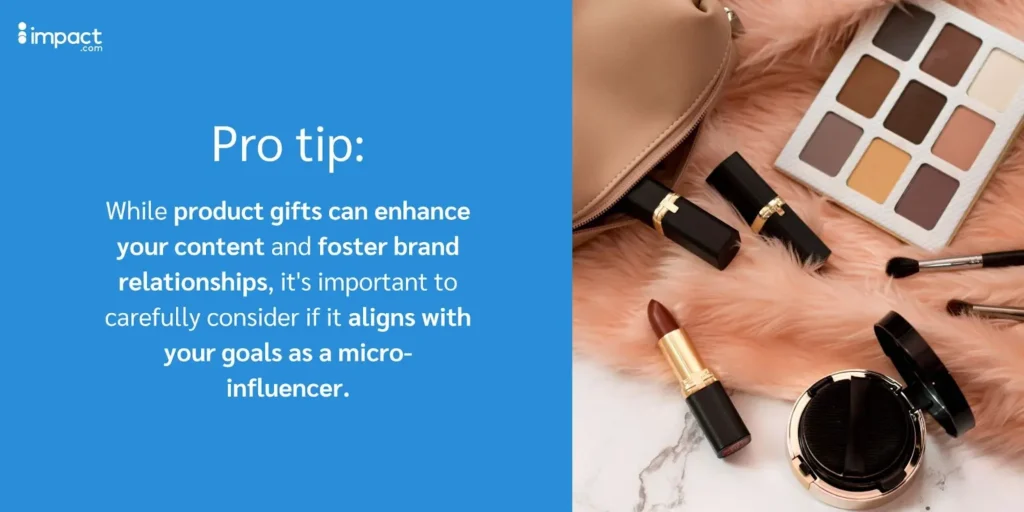
The top 4 tactics influencers use to get free products
For many micro-influencers, landing freebies can feel out of reach. After all, how can you compete with creators who have millions of followers?
The good news? Connecting with brands might be easier than you think. Let’s dive into the most common ways influencers get products and lay the groundwork for successful partnerships.
- Building an online presence that captures brand attention
- Joining influencer campaigns on platforms
- Approaching brands you love directly
- Negotiating free products in existing brand deals
1. Building an online presence that captures brand attention
Many brands use social listening to find influential creators in their niche or brand superfans. Though proactive outreach to brands usually works best, creating a distinctive online presence can get you added to their PR list.
Building a noticeable digital footprint doesn’t necessarily mean having a lot of followers. Instead, it’s more about:
- Authenticity: Brands increasingly seek micro-influencers with engaged audiences who genuinely connect with the content.
- Engagement: Brands value high engagement because it indicates a loyal following that actively interacts with you.
- Quality content: Your content will be more likely to stand out if it aligns with the brand’s aesthetic and values.
- Consistency: Following a posting schedule keeps your audience locked in and attracts brands looking for reliable influencers to collab with.
- Building relationships: Show brands love by tagging them in your posts, sharing your genuine experiences with their products, and participating in relevant brand campaigns.
These steps will help you stand out in the sea of other influencers trying to grab brand attention.

2. Joining influencer campaigns on platforms
You have the best chance of landing free products and PR when you know the brand is already in the market for a partnership.
Signing up for influencer marketing platforms such as impact.com / creator can help you find and apply to active campaigns. These platforms bridge the gap between influencers and brands, making it more straightforward for both parties to find the right match.
These platforms typically pool together a range of brands from various industries, meaning you’re bound to find brands you’re interested in working with. Many platforms even include compensation filters to find collabs that offer free products.
Competition on these listings can be high. Make your application shine by filling out your profile, picking brands that fit your audience, and tailoring your application to each campaign.
3. Approaching brands you love directly
If you know what brands you’d like to work with, pitch them directly.
Crafting an effective pitch is all about highlighting the mutual benefits. Showcase your work, how your audience aligns with their target demographic, and creative ways to feature their products. Spotlight how you can create a mutually beneficial partnership where you and the brand stand to gain.
Also, describe your genuine love for the product—it creates a stronger connection with the brand and makes your recommendation more convincing to your followers. Demonstrating enthusiasm can lead to long-term partnerships with brands and ongoing collaborations.
(Psst… see our detailed pitching tips below).

Source: What brands want: building successful creator partnerships
4. Negotiating free products in existing brand deals
Sometimes, you can get the best of both worlds by suggesting a combination of payment and free products as part of your collaboration agreement.
If you’re already in talks for a flat fee campaign, proposing this payment model can appeal to brands looking to maximize exposure.
Treat this proposal like any other pitch. Make an argument for how receiving free products will enhance your content and make your partnership more lucrative for them.
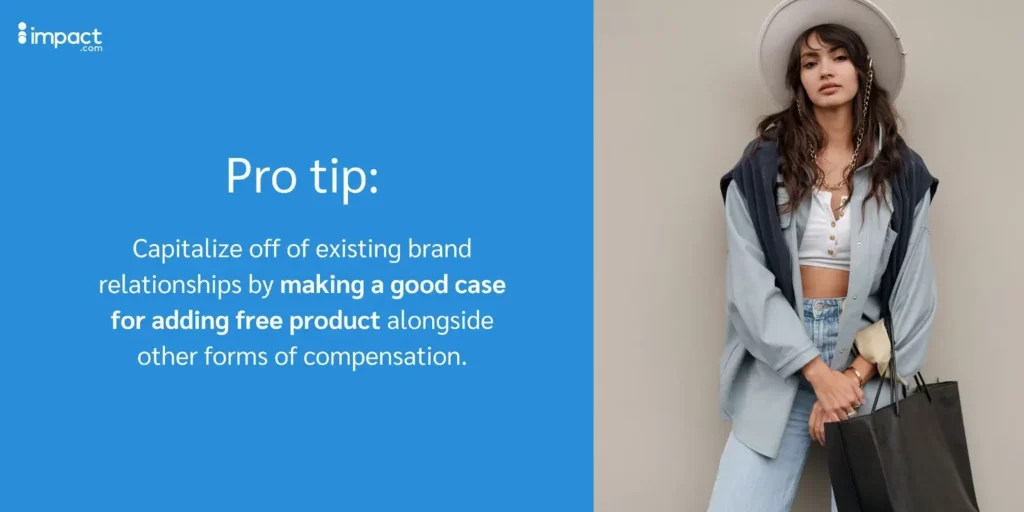
The do’s and don’ts of pitching brands for freebies
Though proactively approaching brands can be intimidating, most companies are open to hearing partnership pitches. Most prefer to hear from you—only 5 percent of brands want to recruit influencers proactively.
The key lies in how you ask.
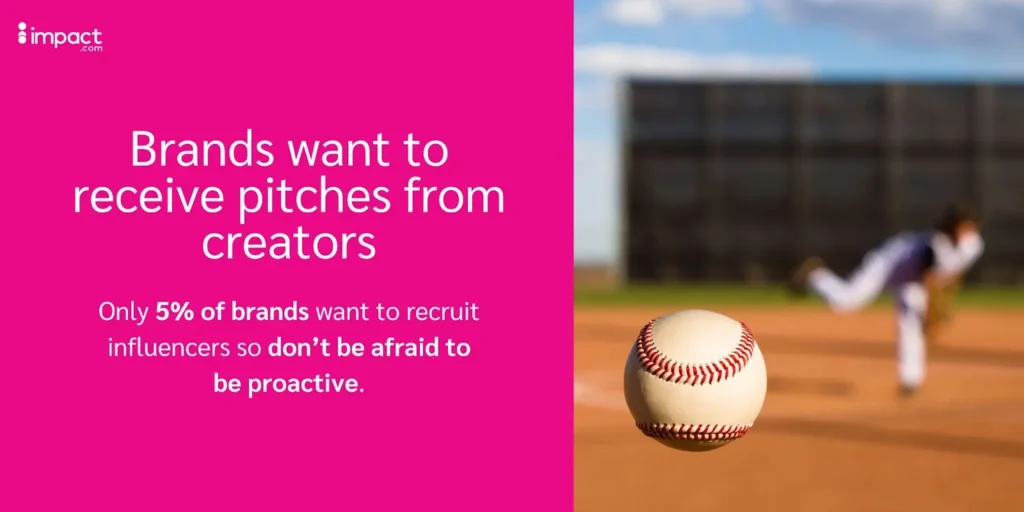
Source: What brands want: building successful creator partnerships
Do:
- Use email. Over half of brands prefer to hear from creators through email.
- Get specific. Talk about why their products are a good fit for your audience.
- Highlight the benefits. Make the brand the focus of your pitch by clearly explaining what they gain by purchasing your product.
- Use data. Support your claims with stats such as engagement rates and audience demographics to highlight your credibility and reach.
- Highlight past successes. Show the brand that you’ve worked magic with companies like them before.
- Explore other partnerships. Consider other ways to use freebies to the brand’s benefit, such as user-generated content (UGC).
- Follow up. Some brands receive many requests for free items, so they may have missed your first email.
Don’t:
- Be generic. Avoid a one-size-fits-all pitch and show real interest in the brand.
- Pitch without a clear plan. Brands want to know exactly how you’ll showcase their product and reach their target audience.
- Be long-winded. Most brand marketing contacts are short on time, so keep it brief.
- Get greedy. The brand has yet to establish a relationship with you, so don’t ask for an excessive number of products.
- Spam your contact. Consider the trail cold if they haven’t responded after 1-2 follow-up emails.
Following these tips will boost your chances of securing product gifts and building lasting brand relationships. A thoughtful and well-crafted pitch can set you apart and pave the way for ongoing collaboration.
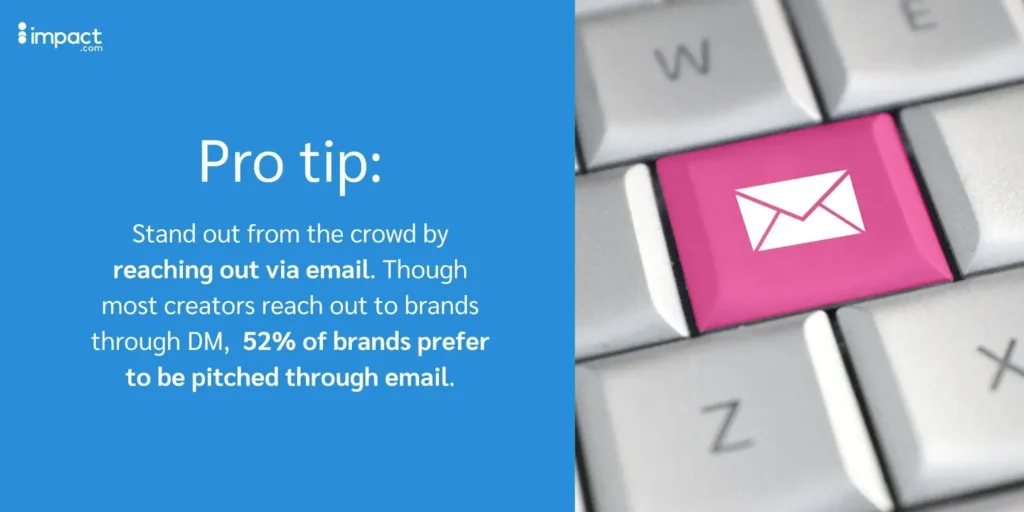
Source: What brands want: building successful creator partnerships
Here’s a pitch email template you can use to ask brands for free products:
Hi [brand contact’s name],
I love [brand name] and can’t get enough of [product name]. It [describes what you love about the product].
I’m a [niche] content creator. I craft content that [describes the kind of content you create].
I’d like to collaborate on [propose a specific piece of content] and have [product name] be the centerpiece. [Explain why you think this fits into their current strategy].
Here’s more information about my work and audience:
- [Media kit link]
- [Portfolio link]
Would you be open to discussing this further? I think we could build a mutually beneficial partnership.
Looking forward to hearing from you,
[Your name]
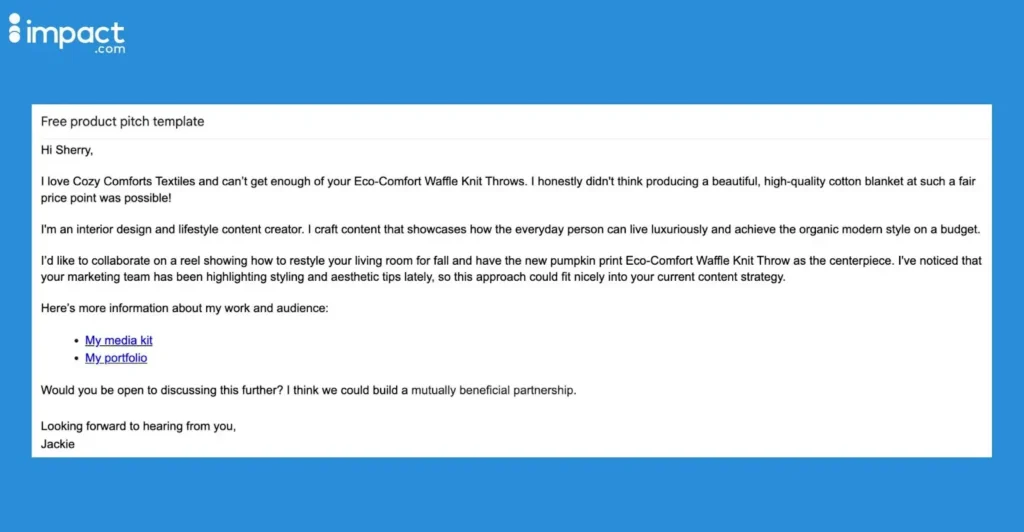
This is an example of what the free product pitch template would look like when filled in.
Maintaining transparency is your top priority
Always keep it real, especially when freebies are involved!
According to FTC guidelines, you must disclose all product gifts. However, this isn’t just about following rules—it’s about building trust.
According to impact.com research, 57 percent of consumers say transparency is the most important value they look for when following an influencer. Your audience wants genuine opinions, so offer honest reviews that reflect your true thoughts.
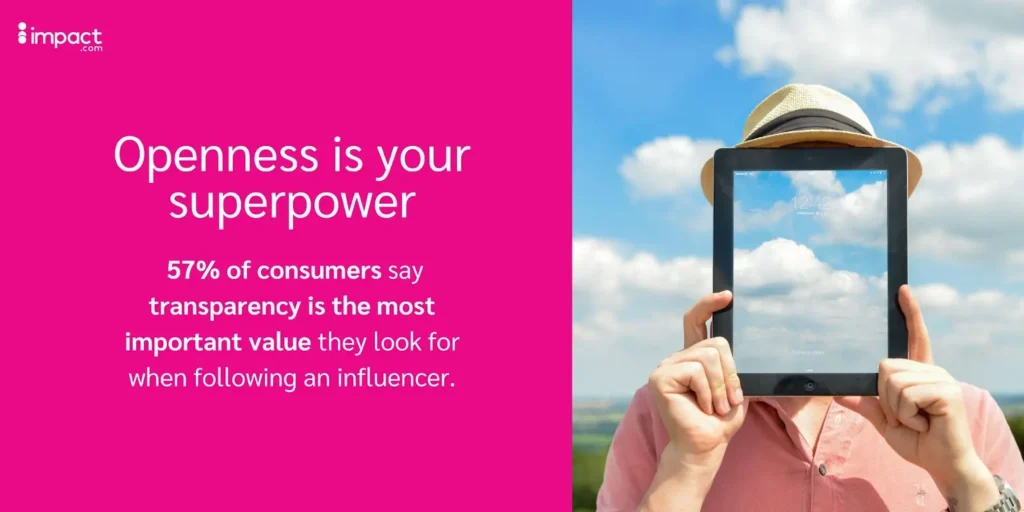
Source: The state of influencer marketing for consumers
Of course, don’t go scorched earth when you’re not vibing with a product. You still have a brand relationship to maintain. However, don’t shy away from providing constructive critiques and feedback. It’s all about striking a balance.
Also, be picky about the products you decide to shout about. Make sure they align with your brand and values. Promoting products that don’t align with your personal brand is like wearing socks with sandals—sure, you can do it, but should you?
Taking a strategic approach to promoting products can:
- Strengthen your brand identity
- Ensure your recommendations are authentic and trustworthy
Find brands and products that you already love
Finding the right companies at the right time can make a huge difference when landing a brand deal. That’s why joining impact.com / creator can be a game-changer for your influencer journey.
Discover and connect with household name brands that offer free products as part of their marketing campaigns. You can test and showcase exciting new products, build meaningful partnerships, and amplify your reach and influence.
Check out more resources to help you on your content creation journey:
- The power of niche: How to get brand deals as a small influencer (blog)
- A content creator’s guide to making money doing what they love (blog)
- 5 research-backed ways creators can stand out when pitching brands (blog)
FAQ’s
The best approach to ask for a paid collaboration is to pitch brands directly. Research shows that only 5 percent of brands want to recruit influencers actively.
The most effective pitches demonstrate how to add value to the brand and use data to support your claims. Do your research on the brand beforehand to show genuine enthusiasm for them and describe how your content fits into their marketing strategy.
A tailored pitching approach will significantly enhance your chances of securing a partnership.
Brand ambassadors often receive product gifts from the brands they represent because they develop closer, long-term relationships with the brand. But, some ambassadors just snag discounts on items—it varies by program.
Becoming a brand ambassador isn’t just about scoring freebies. It’s about creating lasting bonds with brands you genuinely adore.
It’s not considered a best practice for brands to ask creators to pay for shipping on free products. This is a common scam committed against creators.
Sometimes, influencers fork over cash for shipping and never receive the product. If you’re covering shipping, the company should pick up the tab.
Have a creator contract in place before paying anything and ensure it covers shipping costs reimbursement.
Influencers have a variety of compensation methods to choose from—it’s not just about getting free stuff. Many influencers prefer to receive flat fees, rake in performance-based rewards such as affiliate links, or a mix of different payment methods.





